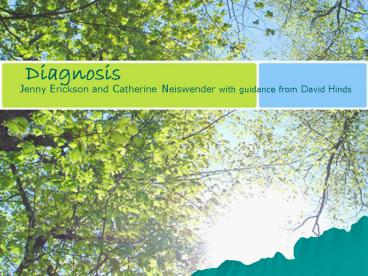Diagnosis - PowerPoint PPT Presentation
1 / 28
Title:
Diagnosis
Description:
Diagnosis. Jenny Erickson and Catherine Neiswender with guidance from David Hinds ... A method for gathering information about how ... Coach McCarthy. Back Up! ... – PowerPoint PPT presentation
Number of Views:158
Avg rating:3.0/5.0
Title: Diagnosis
1
Diagnosis
- Jenny Erickson and Catherine Neiswender with
guidance from David Hinds
2
What is Diagnosis?
- A method for gathering information about how an
organization or community functions problem
identification.
3
The purpose of diagnosis is to determine which
purposeful activity would best initially address
the organizations or communitys issues.
- Organization/Community
Planning Design
Research
Learning
Operating Supervising
Evaluation
4
UW- Extensions Role
- Help the client to discover objective
information, to better understand the situation
to be faced, and to achieve a self-diagnosis.
Coach McCarthy
5
Back Up!
- Many times clients have to be backed up to get
at the root of what is going on - What problem are they tackling?
- Who has been involved?
- What alternatives have
- been looked at?
6
Back Up!
-Conclusions What we believe based on what we
think and feel. -Interpretations How what we
see or hear makes us think or feel. -Data What
we actually see and hear.
7
What are the underlying issues? Use questions
to help clients determine what the underlying
issues are -- not just address the obvious
symptoms.
8
Diagnosis is Underrated.
9
Two Approaches to Diagnosis
- 1.) Checklist approach
- 2.) Branching questions
10
Diagnosis Checklist Approach
1.) Reacts strongly to tastes/smells 2.) Dislikes
anyone coming close 3.) Easily loses
attention 4.) Acts immediately on
impulse 5.) Difficulty getting
started/initiating activities 6.) Reacts slowly
7.) Functions best in routine situations when
he/she knows what is going to happen next
11
Diagnosis Branching Questions
- If you do not ask the right questions, you do
not get the right answers. A question asked in
the right way often points to its own answer.
Asking questions is the A-B-C of diagnosis. Only
the inquiring mind solves problems. - Edward Hodnett, British Poet
12
PRACTICE The Phone Call
- Hello UWEX Agent. I am a member of a local
organization, and we need your help to develop a
survey.
NOW WHAT?
13
Start with Questions
- What is the purpose of the survey?
- What concerns or issues do you hope it will
address? - How will you use the information?
- Have you done surveys before? How did it go?
- What alternatives have you considered?
14
- Your skills may not be what is needed.
- Find out what is needed.
15
Listen for Clues
They respond, The purpose of the survey is to
determine if the members want to dissolve our
organization.
What question would you ask next?
16
Listen for Clues
They respond, The purpose of the survey is to
determine if the members want to dissolve our
organization.
- Evaluation How do you determine if your
organization is effective? - Planning Design Tell me more about the purpose
and vision of your organization? - Learning Do your members have the information
they need to make this decision?
17
Listen for Clues
UWEX Do your members have the information they
need to make a decision? They respond, I am
really surprised, but ask any of our members and
they cant tell you what we do.
How would you respond?
18
Diagnosis is an Art
19
In the End
- Hopefully, the client learns how to
- ask better questions
- challenge their assumptions
- better diagnose their issues in the future
20
Lessons Learned
Listen or your tongue will make you deaf. -
Native American Proverb
21
Buy Some Time
- Lets set up a meeting with key stakeholders to
discuss this further. - Let me get back to you with some ideas.
- Have you contacted
22
Build Strong Relationships
- Create an environment where the client feels free
to speak and share. - They are relaxed
- They feel comfortable with you
- Respond to the clients emotions and language
both are vital
23
Diagnosis Gone Wrong
- 1.) Thinking is guided by a prototype and you
fail to consider the possibilities that
contradict that prototype. - I have seen this one before.
Adapted from Groopman, 2007
24
- It is tempting, if the only tool you have is a
hammer, to treat everything as if it were a
nail. - Abraham Maslow
25
Diagnosis Gone Wrong
- 2.) The client fits a negative stereotype and we
fail to contradict that stereotype. - This organization is lead by a jerk and he is
the problem.
Adapted from Groopman, 2007
26
What does Readiness look like?
- Reasonable time frame
- Core of interested leaders willing to do the leg
work. - Adequate resources
- Willingness, consensus and commitment from the
organization on direction and complete next
steps. - Demonstrated willingness to stick with the plan.
27
Practice
- Break into teams of two
- One person takes on the role of the UWEX Agent.
- Practice asking questions to help the client
diagnose their organizations issues or
opportunities. - Determine which purposeful activity may be the
best fit. - Then switch roles and work through the second
situation.
28
Questions?

